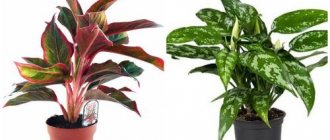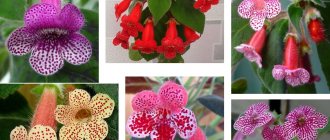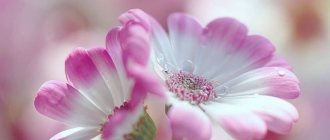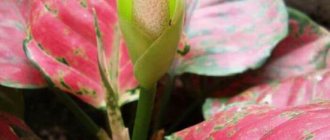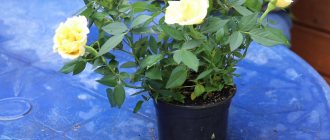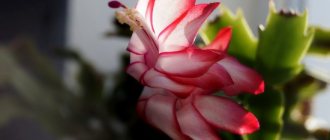Haworthia - a succulent of various types and varieties from the African continent, which is notable for the unusual shape of the bush and its foliage. It is worth choosing such a flower for the truly high-quality evergreen decoration given to it by nature, and for its surprisingly simple, straightforward care.
Dear readers! For you, we have created communities on social networks in which useful articles and interesting ideas are published several times a day! Subscribe and receive useful content in a convenient format!
It’s no secret that Haworthia doesn’t even need to be watered for up to a month, and this omission will not affect its appearance in any way. So, if you don’t always have enough time to care for your home flowers, or it just happens that in the hustle and bustle of your days you forget to water your home flower, pay attention to this rather interesting-looking succulent.
Homeland of the plant and structure
This flower is found in the south, southwest and southeast of Africa. In nature, the succulent prefers to settle in dry places: savannas, on the slopes of mountains and hills. In the wild it can even reach 1 m in height, while indoor varieties barely grow to 15-25 cm and even one of the “technical” characteristics is almost imperceptible growth.
Haworthia is a plant with a rosette of leaves in the above-ground part. They can be colored green, brick, and in some varieties, orange-red. And it is obvious that the main decorative effect lies precisely in the leaves. They are found in triangular, elongated, pointed and rounded shapes. The edges are decorated with frequent teeth or elongated cilia, reminiscent of fluff or cobwebs. And most varieties have pleasant-to-touch growths-tubercles of different colors along the entire length of the leaf blade.
The root system develops mainly to the sides. There, over time, individual young bushes form, which grow most actively after the death of the mother bush.
In the wild, Haworthia blooms annually, throwing out a long peduncle in the central part with inflorescences of small and rather inconspicuous flowers. Flowering indoors is not difficult to achieve, but most often it occurs only once during the entire life of the bush.
Description of the plant
Several species were initially studied. Then, during selection and hybridization, more than 150 plant varieties appeared, differing in external characteristics. Visually, the flower is similar to a cactus or aloe, but has distinctive properties. The following description is given:
- succulent intended for home care;
- maximum height is 30 cm;
- All types, with high-quality care, have dense, fleshy, durable leaf plates;
- the surface of the leaves is often smooth, but may have bulges, irregularities, and roughness;
- the edges of the leaves can be perfectly smooth or have a jagged edge, transparent areas like glass;
- flowering is observed rarely, mainly when growing wild; flowers of an elongated shape and bent petals are formed;
- there are rough depressions on the back of the leaf blades;
- the juice contains toxic substances, but in very small quantities, but it should be kept away from children and animals.
Haworthia succulent grows well in the house and does not require careful care. But if all conditions are met, the leaves will be large, thick, and without signs of dryness.
Growing conditions
The first thing that comes to mind when you are breeding Haworthia is the simplest and most understandable care possible. It is not at all fiction that a flower can easily endure even the owner’s vacation for several weeks. The same can be said about standard care. Watering may be rare and not even regular. It is allowed not to feed the succulent (the standard elements contained in the soil will be enough for it), rarely replant it and not prune it in any way.
Temperature
Remembering the natural conditions in which wild Haworthia grows, we understand that it does not tolerate heat and direct sun.
In summer, for good growth of a succulent, about +20С is enough. And remember that this flower loves fresh air very much, so it makes sense to move it to the balcony or outside throughout the warm season.
In winter, all varieties are dormant, so it is better to keep them slightly cool. Optimal temperature background: +12-15С.
Air humidity
It is no secret that Haworthia is often recommended to all lazy or very busy flower growers. And an important role in this is played by the fact that this plant loves dry air and infrequent watering.
ON A NOTE. The humidity conditions in most rooms are best suited for Haworthia. You won't have to change anything.
In general, Haworthia quite easily tolerates both rare watering and frequent humidification of the air and soil. But if we talk specifically about proper cultivation, then it rather consists in maintaining a certain drought, a desert atmosphere around this succulent.
Lighting
Direct sunlight is strictly contraindicated for Haworthia. Again, we remember the conditions in which a flower grows in the wild. These are the slopes of mountains and large hills, but exclusively in shady places.
It is advisable to recreate the same microclimate at home. If the plant gets too much sun, it is advisable to shade it with screens or hide it behind other more light-loving plants.
What kind of pot does a flower need?
Haworthia has shallow and rather weak roots that grow strongly to the sides. Based on this, you need to select the ideal dishes for growing. It should be wide but shallow.
There must be holes in its bottom for drainage, otherwise due to stagnant moisture the flower may get sick and even die.
Choosing a place to put a flower pot
Any variety of Haworthia will do well on windowsills. But it is advisable to choose windows facing the west or east. South windows are also suitable, but then you will definitely have to shade the flower from too hot sun rays.
What does it look like in the interior?
Most varieties go very well with all modern types of interior. They are quite decorative and are even valued for the special structure of their leaves.
For example, this succulent will fit perfectly with any Scandinavian-style interior, where minimalism of shapes and lines prevails. A flower will not be out of place in a functional, high-tech hi-tech.
Caring for the plant is a pleasure. You can safely not water it for a long time, it doesn’t particularly care about additional humidification of the room, and Haworthia is not very demanding about the length of daylight hours. Therefore, as an undemanding living decoration, this succulent is a frequent choice of modern interior designers.
Conditions of detention
The heat-loving crop naturally grows in warm climates, preferring semi-shaded areas and tolerates dry periods well, storing moisture in the leaf tissues. It is not difficult to create such conditions when growing at home - there is always a place in the apartment where there is no bright sun and not very hot.
Temperature conditions, lighting
The best place for a shade-tolerant haworthia will be a western or eastern window - there is no direct sun. On the northern window, lighting is needed, otherwise the leaves will lose their color saturation, and on the southern flower without shading it will be hot. You can keep the pot on a shelf or stand near the window and rotate it periodically so that the rosette is formed evenly; in the summer, you can take it out onto the balcony or into the garden, covering it from the sun in the heat.
For summer, the optimal temperature is from 18 to 27 °C (higher temperatures are not critical with good care), for winter - from 10 to 15 °C. During the dormant period, some varieties need to lower the temperature to 7-11°C. The minimum temperature at which the flower does not lose viability is +5 °C.
The duration of the dormant period is about four months (November-March), and if the temperature is not lowered during this time, then the decorative effect is lost by spring. Sometimes the roots die off during rest, but you can try to save the flower by digging it into fresh soil and watering it only occasionally.
Soil requirements
Succulents naturally grow on rocky soil that often dries out during periods of drought, so they have adapted to such conditions. Lands with excess moisture and nutrients are not suitable for them. For most types of haworthia, soil with neutral acidity or a slightly alkaline reaction is suitable, so peat cannot be added to it in large quantities, which, moreover, quickly compacts, disrupting air flow. You can use ready-made soil for succulents and cacti, adding a little steamed sand or perlite to it.
Composition of the soil mixture:
- bottom layer (drainage) – small pebbles, expanded clay, small pieces of broken brick;
- middle layer – coarse sand, earth, humus in a ratio of 2:1:1;
- top layer (1-1.5 cm) – perlite, expanded clay.
All components must be disinfected (poured with boiling water, manganese solution, steamed in a water bath) to destroy the eggs of parasites and pathogens.
Features of care at different times
However, despite the fairly simple care of Haworthia, it is, of course, important to observe some seasonal features. Although they are incredibly simple and will not be an impossible task even for those who are just taking their first tentative steps in growing flowers.
in spring
After hibernation, Haworthia begins to awaken in March-April. During this period, it is necessary to increase the frequency of watering; fertilizing is allowed (it is better not to experiment and give preference to complex mineral mixtures).
In the warm season, Haworthia should be watered no more than once a week. At the same time, make sure that moisture does not stagnate in the pot or saucer underneath. It is not worth spraying the air around it until the hot summer.
Spring is the best time to transplant a plant and propagate it.
In summer
With the onset of summer, Haworthia actively grows and can even throw out flower stalks (although it does this only once in its entire life).
In summer, you can water Haworthia 1, maximum 2 times a week, if the weather is very hot and dry. It is better not to overdo it with fertilizers and apply them carefully, up to 2-3 times throughout the summer.
Recommended temperature: Warm, but not too hot. For this succulent, a light breeze blowing its leaves will be useful, and the air should warm up no more than +20-25С.
in autumn
Typically, in October-November, Haworthia's growth cycles slow down and it goes into a dormant state.
From the point of view of indoor care, you should stop all feeding of the flower, and also move it to a cool place. The ideal option is an unheated balcony or glazed veranda, where the constant temperature will remain within +12-15С without sudden changes and no higher.
The plant should be watered much less often than in summer. About 1 time per month.
ADVICE. The correct watering of Haworthia in the autumn-winter period is as follows: before moistening the soil, bring the flower 1-2 days before into a warm room, water it, then let it stand in the warmth for another 1-2 days and only then take it back to a cool place until the next watering.
in winter
In winter, Haworthia needs to be cared for in the same way as in late autumn.
Haworthia care
Haworthia is a very attractive and spectacular plant, which is very undemanding to care. Therefore, any person without any skills or knowledge can cope with its cultivation. It is enough to know only a few rules for care.
When extreme heat sets in, a bush growing where it receives a lot of sunlight must be shaded by moving it to an appropriate place. If possible, a terrace or balcony would be an excellent option. This succulent plant is not demanding on the level of humidity, which means there is no need to create special conditions for it.
It is important to regularly ventilate the room where the flower is grown throughout the year.
You can water your haworthia only with soft water. It can be rain or settled. During watering activities, only the surface layer of the soil mixture is wetted; for this type, this will be quite sufficient. In summer, this is done when the soil dries out, and in winter, if the plant is at a suitable temperature of +10-+12 degrees, only once every 30 days. If it was not possible to ensure such conditions and the thermometer is at +18 - +20 degrees and exceeds this value, then watering should be done once every 14 days. When watering, you must protect the outlet from liquid getting into it, as this can cause the formation of rot.
Since flowers do not add decorative value to the plant, they must be removed when flower stalks appear. This way you can preserve the strength of the bush.
Fertilizer application
You need to feed the succulent regularly. Such events are held from mid-spring to August. Fertilizers are applied at intervals of 30 days. An excellent option for feeding would be the mixtures used to fertilize cacti, but the concentration level should be half that indicated on the label. Gardeners with extensive experience in growing such plants talk about the need to mix fertilizers with water used for irrigation. With the onset of autumn, all feeding stops.
Varieties and types of Haworthia with photos and names
The plant genus includes up to 150 flower varieties. And each of them, perhaps, can easily find its own characteristics and strong decorative sides.
Haworthia Striped
An easy-to-care variety with white grooves on the underside of the leaves.
Some stripes can be so wide that they visually dominate the main green coloration.
Haworthia Cooper
Quite an exotic and rare variety.
She will have to be monitored in terms of more sensitive care.
But the real reward will be the unusual leaves of the succulent, which at a certain angle resemble balls that transmit light in the upper part and seem to glow from within.
Haworthia Limifolia
Classic Haworthia with pointed leaves.
And also with a wavy pattern of tubercles along their entire length.
Haworthia Pearl
One of the most beautiful varieties in terms of decorative qualities.
Its main feature is white droplets of tubercles that resemble pearls.
This variety of succulent is also one of the tallest among all indoor succulents.
It grows up to 10-15 cm in height.
Haworthia navicularis
It is a small bush.
Densely collected boat leaves.
Haworthia Retuza
Excellent variety for growing on the window.
It is notable for its dense and large rosette bush.
And also in a variety of shades of color: from light green to purple.
Haworthia Fasciata
Almost classic in appearance, Haworthia.
It has sharp, elongated leaves decorated with white growths.
They fold into longitudinal strips.
Haworthia Mix
The variety is also called Maugani.
It has unusual leaves that are slightly blunt at the tips.
And the colors are very different: brown, purple, dark green, light gray.
Haworthia Reinwardt
The variety can grow up to 25 cm, but rarely.
This Haworthia is notable for its spirally twisted leaves.
And also good growth with a dense mat in width and height.
Haworthia Limofolia
This variety is the most light-loving.
Its main uniqueness is the always different, unique pattern of wavy tubercles throughout the leaf.
And also a light lemon shade on the upper side of the leaves.
Haworthia sinuous
This variety is often confused with aloe.
If it were not for the small white speckled balls on the contours of the leaves.
Haworthia Concolor
A variety densely covered with white tubercles.
It seems that the whole plant is covered with frost.
Haworthia Truncata
Unusual variety.
It seems as if the leaves of this succulent were deliberately cut off at the tips.
In fact, they just grow like that - with blunt tips.
The cut itself has a whitish tint.
Haworthia Alba
A variety covered with transverse stripes of white or gray.
Sometimes all the leaves are 80-90% white.
Haworthia Maugani
A variety with growing leaves that are cut off in appearance.
But only Maugani can be of very different shades.
From green to white and even brown.
Haworthia Attenuata
This is another name for Haworthia drawn.
It grows up to 7-10 cm in height and is decorated with chaotically scattered whitish droplet balls - sort of growths.
Haworthia Tortuosa
A bush with very densely growing pointed leaves.
They are fleshy and have white or gray tubercles randomly scattered along their entire length.
Haworthia drawn
An incredibly popular variety.
It is chosen for its almost complete absence of maintenance requirements and pleasant appearance with pointed leaves and small white tubercles over their entire surface.
Haworthia sticky
It is characterized by a very tight fit of the leaves to each other.
Another distinctive feature is the climbing stem.
Haworthia Cymbiformis
Another name is Scaphoid.
It develops leaves that look like boats.
They are collected in a dense rosette of a bush.
If there is enough light, the leaf blade will turn several shades of green from light to dark.
Haworthia Viscose
A characteristic feature of the variety is leaves growing three in a row.
Because of this, the bush itself resembles a dense stack of folded napkins.
Haworthia Tesselata
It is also called Chess Haworthia.
Its design on the outer side of the leaf is noteworthy.
It is strewn with transversely arranged veins.
Haworthia Pumila
Very similar to the pearl variety.
But only this time the growth balls are not completely white, but seem to be transparent.
Like frozen drops of dew.
Haworthia Bayeri
Dwarf variety.
Bayeri is surprising in that it spreads like a small mat over the ground where it grows.
Haworthia Big Band
A variety of striped variety.
Just not with green, but with a lilac or reddish color of the leaf blade.
Haworthia Obtuza
A rare variety with leaves that look like water bubbles.
They are easily visible.
They also create the illusion of sea foam.
Haworthia dulled
The variety is very compact.
It produces non-pointed leaves.
They are packed together so tightly that they give the impression of neat and directed growth.
Haworthia Spider White
This is a small bush.
Which weaves around a pattern of transverse white stripes.
The stripes obviously resemble cobwebs.
Haworthia Magnifica
Succulent with dense leaves.
The leaves grow in the shape of a star.
Haworthia Nigra
A rare variety with dark green foliage.
There are also inclusions of black or brown tubercles.
Biological description
The leaves of the plant are mostly fleshy, dark green, form a rosette, located either at soil level or on a slightly raised short stem. Some species resemble juveniles in appearance. In many species, the tops of the leaves have transparent areas - windows that allow light to penetrate deep into the tissues. In some species of Haworthia, the leaves are covered with white warty tubercles. The edges of the leaves can be smooth, with teeth, “cilia”, and long points.
Plants often produce a large number of lateral shoots, forming dense cushion-shaped turf.
The flowers are small, white, very similar in different species.
How Haworthia blooms
As a rule, flowering time occurs at the end of spring or the first days of summer.
The flowering of Haworthia itself is very inconspicuous and fleeting. The plant throws out one long peduncle, on which small, most often white flowers appear. Haworthia can grow from 5 to 20 years, even indoors, but it can bloom only once.
But in any case, the main decorative feature of Haworthia is always its beautiful and extraordinary leaves. Most gardeners grow the flower precisely because of the unusual appearance of the bush, and in order not to waste the plant’s energy on frankly inconspicuous flowering, they cut off the peduncle as soon as it begins to appear.
Problems in caring for Haworthia adhesive
Among the diseases that pose a threat to succulents, it is worth highlighting root rot. Symptoms of this disease are stunting and wrinkling of leaves, reducing the size of the succulent. Root rot can occur due to constantly wet soil. To protect Havrtiopsis from harm, adjust the frequency of watering and let the soil dry well.
For most pests this species is not of interest. The only one that can harm the plant is the mealybug. This insect is quite easily removed mechanically.
Transplanting a plant step by step
The plant should not be replanted often, as it grows slowly. In the Haworthia standard, the pot is changed every 2-3 years or even less often.
- Carefully remove the flower from the old pot so as not to damage the weak surface roots.
- Clean the root from the soil and, if desired, treat it with a weak solution of fungicide.
- In a new container, cover the drainage area to about 1/3 of the volume.
- Plant the bush and cover it with soil without compacting it.
- Place the plant for 10-15 days in a bright place and shade it from direct sun.
A signal that this succulent already needs replanting is usually the drying tips of the leaves.
Haworthia transplant
It is not necessary to replant the Haworthia plant annually, only as needed if the flower becomes crowded. This usually happens after two to three years. A wide, round, shallow pot is best suited for it to avoid stagnation of water in the roots; besides, in a large pot it will grow downwards rather than upwards; in a small pot the leaves will become too small. Good drainage is necessary; you can also add a little expanded clay and coarse sand to the soil for planting. Both cactus soil from the store and ordinary soil are suitable for Haworthia, but you need to monitor the pH of the soil - an acidic environment is destructive for Haworthia.
How to plant a flower
Haworthia grows in width, and this quality is most often used in its propagation. The old bush remains in the center, and the young ones grow next to it. They can be carefully separated from the mother bush during the next transplant.
The root system is trimmed with a sharp knife and the new shoot is transplanted separately.
It is recommended, however, not to immediately move a sprout with a damaged root into the ground, but to keep it for up to 7 days, without planting it anywhere, to heal the wounds, and only then replant it in a permanent place.
Watering and humidity
Haworthia is no stranger to drought. The flower is more comfortable without regular watering than with it. The main condition is that the soil must dry completely after the previous moistening.
It usually takes me 10-12 days. But it all depends on temperature, humidity, substrate density, and time of year. For example, in winter you should water no more than once every 1.5 months.
Haworthia easily tolerates drought for 6 to 8 weeks, which means you can maintain such a break all year round. But in this case, it is worth giving the plant tropical downpours, that is, watering it so abundantly that the water passes through the entire thickness of the soil and spills into the pan. After half an hour, the water must be drained.
Water with warm, settled water and make sure that the water does not get into the center of the sockets. The flower does not need spraying at all; moreover, it begins to rot.
Reproduction in different ways
Haworthia lends itself to all the most common methods of reproduction.
Propagation by cuttings
During the next transshipment, you can divide the root system and the bush itself into several parts and transplant them into different pots.
By the way, many advise not to immediately replant damaged parts of plants, but to let them dry in the air for several days so that they do not develop root rot.
Leaf propagation
The leaves are separated from the mother plant and placed in a separate container in sandy soil. There is no need to dig them in. It is also not worth maintaining high humidity.
Usually after 2-3 weeks the leaf takes root (you can spray it with Kornevin). Over time, a rosette of a new bush appears nearby, and the mother leaf bush gradually dies off.
How to reproduce by children
A very simple option. During the next transplantation, young growth calves from the main bush (in adult plants, it itself grows along the edges of the main plant). Its root is unraveled and a new bush is planted separately.
How to root a flower
Haworthia easily takes root in sandy-peaty soil and without high humidity. But you can simplify the reproduction process by adding the drug “Kornevin”.
How to plant without roots in a pot
Even leaves of Haworthia take root easily, let alone whole cuttings, etc. If you need to replant a plant without a root, then you can simply place a separate healthy leaf on light soil and not even dig it in.
Over time, it will give a root, and then a new plant will emerge from it. The old part of the leaf will simply die off.
Reproduction
An adult haworthia forms daughter rosettes at the base of the bush. When the young plants grow 2-3 leaves, they are carefully separated from the adult succulent.
The shoots with roots are immediately planted in a moderately moistened substrate and cared for according to the standard scheme.
If there are no roots on the cutting yet, it is air-dried for 4-6 hours, and only after that it is planted in damp vermiculite or sand. A transparent cap is installed over the seedlings, and the plants are placed in a warm and bright room. Periodically, open the greenhouse and moisten the soil with warm water from a pipette. Rooting lasts about a month.
A Haworthia leaf, torn from an adult and healthy rosette, is also rooted in the same way.
Attention. The best results when propagating succulents are obtained in spring and summer.
Watering at home
Water your Haworthia so that the soil is not wet for a long time. It is recommended to wait until it dries to a third of its depth. Remember, succulents are more prone to drought than excessive humidity.
- In summer, water the plant no more than 1-2 times a week.
- In autumn and winter - 1-2 times a month.
Completely empty the saucer under the pot 10-20 minutes after watering. It is not particularly recommended to spray Haworthia. But even if there is a desire to increase the air humidity in the room (for example, due to neighboring plants), be sure to remove any drops from the leaves of Haworthia.
Haworthia diseases and their treatment
- if the leaves of the haworthia become long, and the rosette is loose and elongated, then it does not have enough light, it is worth changing the place;
- If during the winter the bright tubercles on the leaves fade, the edges of the leaves bend, you need to lower the air temperature. Add pebbles with water to the tray;
- if the stem and rosettes of the haworthia are stretched too much, the plant needs to be replanted and the children removed;
- if the flower becomes sluggish and the leaves begin to separate easily, it means that there is too much watering - it should be stopped until the flower comes to life;
- if the color of the leaves begins to vary, there is too much feeding. It is necessary to exclude fertilizers with nitrogen;
- if the haworthia leaves begin to rot and turn black, there is too much water, the air temperature is too low.
Diseases and pests
Haworthia is slightly susceptible to diseases and pests. But even this unpretentious flower has problems. First of all, most of them are associated with excess humidity in the air or soil in the pot.
- The most dangerous disease is fusarium or root rot. Weak roots are susceptible to it due to high soil moisture. With severe development of the disease, the leaves at the base turn black and easily tear off. The only thing that will help is replanting it in a new breathable soil and removing all the roots damaged by root rot.
- Among insects, scale insects often settle on Haworthia. And this is due to the fact that the plant becomes infected due to its proximity to diseased flowers. Scale insects are dangerous in the sense that, feeding on the sap of the plant, they dry out its leaves.
- Sometimes root worms appear in the soil. You can understand that the pest has long been attracted to Haworthia by the whitish coating on the leaves of the flower and white flakes on the surface of the soil - this is the waste of the insect.
Haworthia is usually not difficult to treat. They are saved from diseases by transplanting the healthiest parts of the bush. And they get rid of pests using standard treatments with folk remedies or purchased medications.
Why do Haworthia leaves dry out?
Leaves are the main decorative element of Haworthia. If they do not look their best, then all the beauty of this flower is lost.
Leaves can dry out:
- Due to the presence of scale insects or root scale insects;
- Due to the proliferation of spider mites (dry air);
- The tips dry out when there is not enough heat or the flower is blown by too cold a wind;
- If the flower receives a lot of direct sunlight;
- Leaves may also turn yellow or red due to an excess of fertilizers.
Haworthia pests
The flower is also almost not susceptible to pests. There are only two of them: the root mealybug and the scale insect (shield aphid).
Shchitovka
Symptoms of appearance: convex brown growths first appear on the leaves, then a sticky coating (these are waste products of the scale insect; if such a coating appears, it means the scale insect has already multiplied), then they dry out and completely fall off.
What to do: you need to carefully treat the plant - either wash it under a warm shower, or remove all insects using a cotton pad generously soaked in a thick soap solution or alcohol. Then you need to treat the plant with insecticides, for example, Actellik.
The scale insect is an insidious insect: it has a “shield” on its back, thanks to which it is easily protected from chemicals, so it will require not just one treatment, but several – two or three. It is advisable to treat each time with new drugs, because the scale insect easily adapts. The break between treatments is 7-10 days. Cross-treatment with two different drugs is allowed.
Prevention: periodically check all plants in the house (scale insects easily and willingly migrate from flower to flower), the sooner you discover that a flower is infected, the better. Most often, scale insects fly to a plant from another plant, so if you buy a new pet, quarantine it for at least a couple of weeks to make sure that there are no insects on it.
Also, scale insects (unlike many other pests) prefer shade and moisture, so try not to overdo it with watering.
Root mealybug
Symptoms of appearance: deformation of the leaves, a wax-like coating and white flakes are noticeable on the ground in the pot.
What to do: remove insects from the plant, as in the case of scale insects, then treat with insecticides (Aktara, Inta-Vir, Fitoverm are suitable) at least three times. The interval between treatments is two weeks.
Prevention: regular inspection, do not allow high humidity in the room, do not water too often (Haworthia should be watered only after the soil has completely dried).
How to resuscitate?
Rescue measures are quite simple.
Relocating to a more favorable place (for example, where it is not damp and warm) helps with illnesses. Timely treatment will help against pests - just don’t get carried away, but act strictly according to the instructions.
Otherwise, remember the main rules: Haworthia does not need direct sunlight, it does not like humidity and loves coolness, not extreme heat. Accordingly, choose such a place for her, and you will not have to face most common problems.
Location and temperature
All succulents love light and warmth. Therefore, we place them on eastern, western window sills and even southern windows, but in this case we shade them from sunlight. Because of them, variegated plant species lose color or fade.
Indoor haworthia cannot tolerate too high a temperature. If the room is very hot, I leave water in the tray. The flower will then take care of itself, gradually drawing out moisture when it needs it.
Although in its natural habitat Haworthia easily tolerates temperature swings, indoor succulents are more delicate - they can withstand up to 30 degrees in summer, and up to 10 in winter.
In the summer, I try to take the plants out onto the veranda; they don’t like drafts, but they love fresh air.
Common mistakes
Despite the ease of growing Haworthia, there are the most common mistakes in caring for it.
- With a minimum of light, the leaves of the flower become limp, drooping and are easily damaged even from touching.
- If the plant gets a lot of direct sun, the leaves on it darken and curl. Shade the place.
- This flower can be easily filled. If there is excessive moisture, the leaves become watery, and in the worst case, they rot and turn black at the base.
Avoid these mistakes to ensure your Haworthia always remains beautiful and fragrant.
Variety of species
- Haworthia fasciata (striped) - this variety is trunkless. It is made up of dense rosettes located at the roots, made of leaf plates that are quite thick and original and have a lanceolate shape. On the surface side the leaf is smooth and green in color; on the inside it is covered with white convex stripes. Their length is about 5 centimeters, and the leaflets are no more than one and a half centimeters wide.
- Hawortyia attenuata (drawn) - similar to the previous plant, but not as spectacular. The leaf blades are covered with raised dots, which may be green or white. They have a lanceolate shape, are located upward, about 7 centimeters long and one and a half centimeters wide.
- Haworthia tortuosa - also called tortuous aloe. This variety has a small trunk, with a height not exceeding 15 centimeters. The dark green leaves grow up to 2.5 centimeters in length and have a warty surface on the inner convex side.
- Hawōrthia viscōsa (sticky) - this bush can grow up to 20 centimeters. The erect leaves are small in size and oval in shape, arranged in three rows. The leaf is slightly bent at the end. They are 2.5 centimeters long and 1.5 centimeters wide.
- Haworthia cymbiformis (scaphoid) - This plant has fleshy, glossy, lance-shaped leaves. They form a rosette located at the base with a diameter of 10 centimeters. When side shoots appear, it increases in diameter to 20 centimeters.
- Haworthia margaritifera (pearl) is a herbaceous perennial succulent with an almost completely absent stem. It consists of hard leaves 8 centimeters long and 2.5 centimeters wide, with an oval shape and a slight point. They are painted green and studded with white pearl-like beads on both sides. Their formation occurs in the root rosette.
- Haworthia tesselata (checkerboard) - small rosettes composed of thick leaves whose shape is triangular and whose edge is covered with teeth. A grid is drawn with white strokes on the outside of the leaves. The inner one has a warty surface.
- Haworthia reinwardtii (Reinwardtii) - an elongated rosette of this species consists of fleshy triangular-shaped leaves, 3.5 centimeters long and 1.5 centimeters wide. The pronounced dark rows that cover the inner side of the leaf blade lengthwise and crosswise are strewn with whitish warts. This species includes zebrina, one of the varieties, its leaves are strewn with bright warts, the leaves are larger in size and the bush itself is very impressive. The young bush has an erect stem, but after a while it takes a vertical position.
- Haworthia retusa - This plant is decorated with hard, fleshy leaves consisting of three sides about 5 centimeters long. The top of the leaf is slightly bent. Surface with transparent windows and light strokes. Leaf color may vary. Green with brown, green with a hint of red and green. Varieties can be slightly chlorophyllous and variegated.
The Giant variety has large dissected leaf blades.
Haworthia has a strong immune system that protects it from diseases. The cause of the disease can only be a violation of agrotechnical rules. If you follow all the rules for caring for the plant, then for many years you will not have to worry about its health.
Answers to popular questions
Why is my Haworthia growing slowly?
Don't rush to sound the alarm. Extremely slow growth is a feature of this plant.
Leaves often turn yellow and fall off.
Most likely, the reason lies in the too bright sun hitting the plant.
The leaves do not look dry and hard, but soft and drooping. Why?
It is very likely that you are pouring Haworthia. This flower, on the contrary, loves drought, and generally needs to be watered no more than once a week in the summer. And in winter - once a month.
Reviews from flower growers
Haworthia is suitable for those who sometimes forget to water their flowers, because they come from arid countries and are able to retain water in the stem and leaves for a long time.
Beautiful, lush green, rough leaves captivated me with their beauty. On the kitchen windowsill, in an area of direct sunlight, the plant began to quickly wither, and the leaves began to rot and fall off. After transplanting it into another flower pot for cacti, I left it in the bathroom on the washing machine. And what do you think? Juicy greenery, new shoots simply filled the pot, I had to plant it out. Gardekja
https://otzovik.com/review_820753.html
I like it so much that I talk to it, it doesn’t bother me to care for it, it grows very slowly, anyone who grows it knows.
I heard that it can even bloom occasionally, but that didn’t surprise me. Clarice
https://irecommend.ru/content/vot-nichego-s-khavortiei-osobogo-ne-delayu-tolko-razgovarivayu-i-polivayu-ona-rastet-foto
A beautiful plant, completely unpretentious to care for.
Looks great on your desktop near your computer or on the windowsill. Beautiful living joy. Siderted
https://otzyv.expert/ekzotika-na-okne-1385279
How to make a succulent garden - video
Haworthia turned out to be completely unpretentious in care. The variety of species will allow almost any gardener to choose a plant to their liking. And if you also create a mix of succulents, you can bring a unique charm to the interior of your apartment.
- Author: Diana Nikiforova
I never cease to be convinced that life is wonderful. Rate this article:
- 5
- 4
- 3
- 2
- 1
(3 votes, average: 4.3 out of 5)
Share with your friends!
Varieties of Haworthia Striped
There are several registered, widely known and widespread cultivars. But Haworthias, including the Striped Haworthia, interbreed easily within and between species. Sooner or later, many breeders begin to breed hybrids by pollinating flowering plants. At the same time, the results of their work are not registered, but are sold via the Internet with a description, photo and indication of the parent species; they rarely care about preserving varietal characteristics during further propagation.
Concolor
Haworthia fasciata var. Concolor is a variety that differs from the main type in that the leaves are not striped, but covered with small, chaotic white dots. The specks are located on both sides of the plates.
Alba
The Alba variety, on the other hand, produces large, convex, intermittent ridges of white growths. They look like sugar icing squeezed out of a confectionery syringe; they make the leaves striped, and it is not clear which color is more dark green or white.
Big Band
Big Band is an interspecific hybrid of Pearly and Striped Haworthia. The rosette reaches a diameter of 20 cm with a height of 12-14 cm. The white dots are large, only on the underside and along the edge of the leaf.
Variegata
This is not a variety, but a rare unstable mutation of the Striped Haworthia species. You shouldn’t buy a dark green plant and rely on the sellers’ assurances that “white leaves will appear soon.” There is no guarantee that young plates will be deprived of chlorophyll.
Benefits of Haworthia
Haworthia is believed to bring positive energy into the home. It is recommended to place the pot with the plant in the kitchen or work table. The flower charges with vital energy, improves mental abilities, and helps in work. If it is present in the room, a person gets less tired.
The leaves have an antiseptic and bactericidal effect. They are beneficial if they are applied to the cut site as a top layer. Thanks to this, the risk of developing inflammatory processes and the penetration of infectious agents is reduced, and the damage heals faster.


